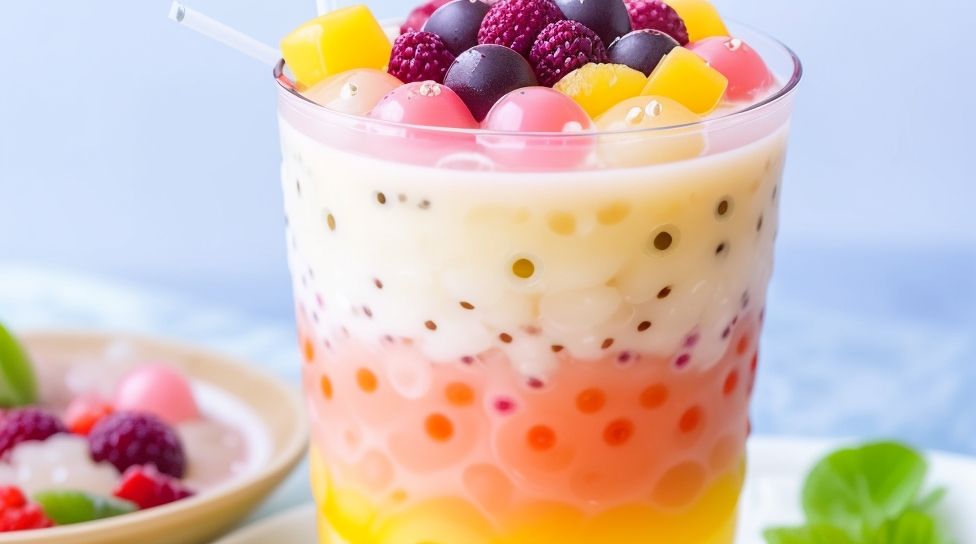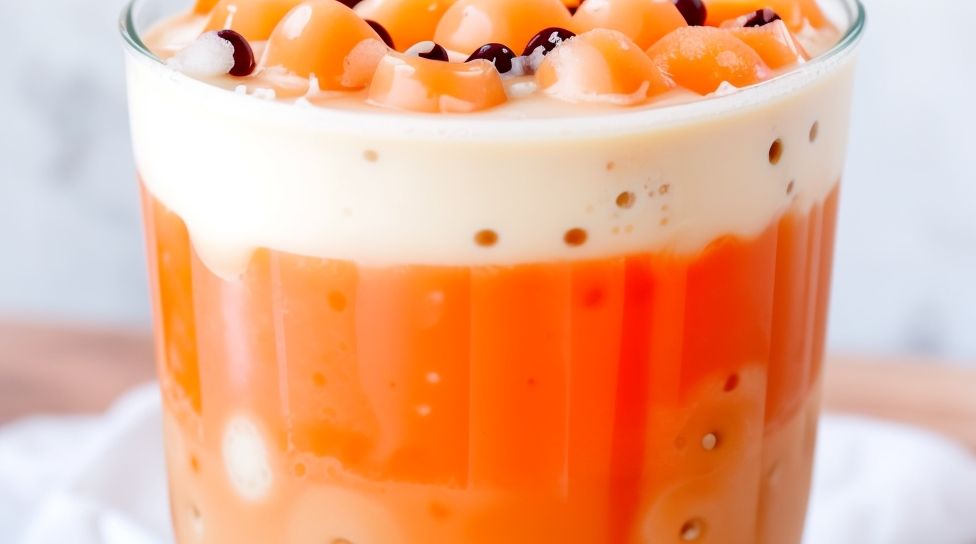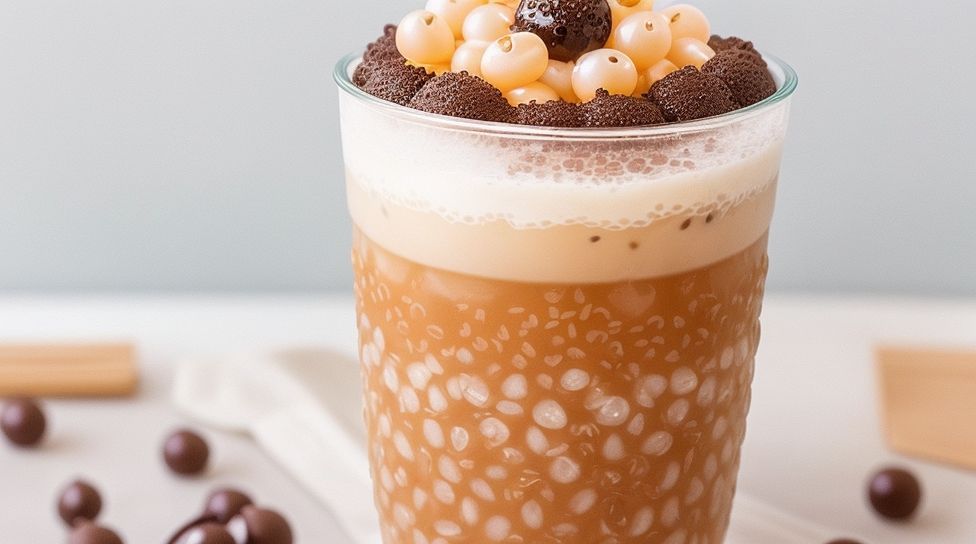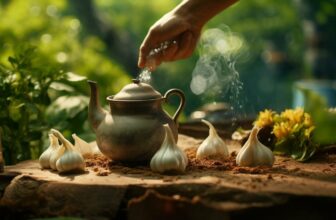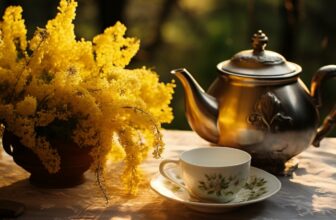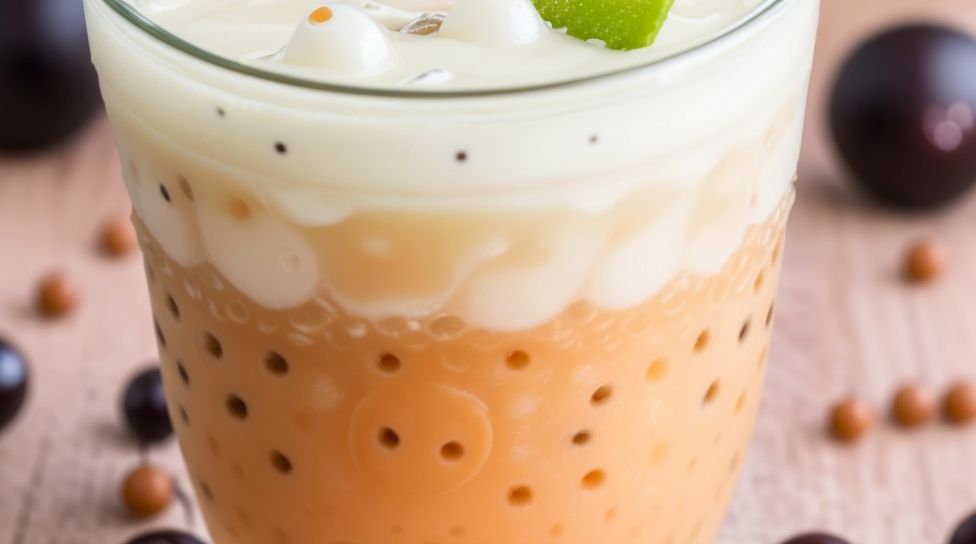
Boba tea, also known as bubble tea, is a popular Taiwanese beverage that has gained international recognition for its unique combination of tea, milk, and chewy tapioca pearls. This article will provide insights into the world of boba tea, including its history, popular variations, and a step-by-step guide on how to make it at home.
Boba tea is known for its intriguing blend of flavors and textures. The main ingredients include tea (often black or green tea), milk or creamer, sweeteners like sugar or honey, and tapioca pearls. These chewy pearls add a delightful element to the drink, making it a truly enjoyable experience.
What sets boba tea apart from other tea-based beverages is the addition of these tapioca pearls, which sink to the bottom of the cup and are sucked up through an oversized straw, allowing for a burst of flavor and texture with each sip.
To delve deeper into the world of boba tea, we will explore its history, including its origins in Taiwan and its rise in popularity throughout the world. We will also discover the various popular variations of boba tea, including Taro Milk Tea, Matcha Boba Tea, Thai Milk Tea, and Strawberry Boba Tea, each offering a unique twist on this beloved beverage.
For those interested in recreating the boba tea experience at home, we will provide a step-by-step guide on how to make your own boba tea. From boiling the boba pearls to preparing the tea base, sweetening and flavoring the tea, and finally assembling the drink, we will cover all the necessary steps to create a delicious boba tea.
To ensure you achieve the perfect balance of flavors and textures, we will also provide tips on choosing the right boba pearls, adjusting the sweetness and creaminess to your liking, and experimenting with different flavors to personalize your boba tea experience.
By the end of this article, you will be equipped with the knowledge and skills to make your own scrumptious boba tea and enjoy this delightful beverage in the comfort of your home. So, let’s dive into the world of boba tea and explore the endless possibilities it offers.
Key takeaway:
- Boba tea maximizes creativity: There are numerous variations of boba tea, allowing for endless flavor combinations and unique creations.
- Ingredients make boba tea unique: The combination of boba pearls, tea base, and flavorings result in a distinct and satisfying beverage experience.
- Making boba tea at home is easy: Following a few simple steps, anyone can enjoy the deliciousness of boba tea in the comfort of their own home.
What is Boba Tea?
Photo Credits: Www.Teamastershub.Com by James Wright
Boba tea, also known as bubble tea, is a popular Taiwanese drink that originated in the 1980s. It is a unique beverage that combines tea, milk, and chewy tapioca pearls, often served with a wide straw to allow for sipping and chewing at the same time. Here are some key characteristics of Boba tea:
- Tapioca Pearls: Boba tea gets its distinctive texture from tapioca pearls, which are small, chewy balls made from tapioca starch. These pearls are often cooked and sweetened, giving them a slightly gummy consistency.
- Tea Base: The tea base used in Boba tea can vary, but it is typically made from black tea or green tea. There are also fruit-flavored or herbal tea options available.
- Milk: Boba tea can be made with or without milk. When milk is added, it creates a creamy and smooth texture in the drink. Common types of milk used include dairy milk, non-dairy milk alternatives like almond milk or coconut milk, or condensed milk.
- Flavorings and Sweeteners: Boba tea can be customized with a variety of flavorings and sweeteners. Common options include fruit syrups, honey, sugar, or flavored powders such as matcha or taro.
- Toppings and Additions: Apart from tapioca pearls, Boba tea can also include other toppings and additions. These may include fruit jellies, aloe vera, grass jelly, or flavored popping boba, which are small juice-filled balls that burst in the mouth.
- Serving Style: Boba tea is typically served cold or over ice, making it a refreshing beverage, especially during hot weather. It is often presented in a clear cup with a sealing film or lid to prevent spills during transportation.
Boba tea has gained popularity worldwide due to its unique taste, fun texture, and customizable options. It has become a staple in many tea shops, cafes, and bubble tea chains, offering a wide range of flavors and combinations to suit individual preferences.
What are the Ingredients of Boba Tea?
The ingredients of boba tea, also known as bubble tea, can vary slightly depending on the specific recipe. However, they typically include tapioca pearls, tea, milk, sweetener, ice, and optional flavorings. Tapioca pearls are the chewy, black balls that give boba tea its unique texture and flavor. The tea used can be black tea, green tea, or fruit teas. Milk or non-dairy alternatives like almond milk or coconut milk are often added to create a creamy element. Sweeteners such as sugar, syrup, or flavored syrups like caramel or vanilla add sweetness to the tea. To make the drink cold and refreshing, boba tea is usually served over ice. Optional flavorings like fruit purees, powders, or extracts can be incorporated to enhance the taste. Popular choices for flavorings include taro, matcha, strawberry, or Thai tea flavors. With boba tea, you have the freedom to customize the ingredients based on your personal preferences and dietary restrictions. Have fun experimenting with different flavors and combinations to discover your favorite boba tea recipe!
The history of boba tea dates back to the 1980s in Taiwan. It was created by a tea house called Chun Shui Tang, which initially served cold tea with added fruit flavors. Then, they introduced tapioca pearls to the beverages, and the unique texture of boba quickly gained popularity. The trend spread throughout Taiwan and eventually gained international recognition. Today, boba tea is enjoyed in various flavors and variations worldwide.
Boba tea is like a delicious game of surprise, with those little chewy tapioca balls that have you wondering if you’re drinking or chewing your beverage.
What Makes Boba Tea Unique?
What Makes Boba Tea Unique?
Boba Tea stands out from other types of tea due to several key factors:
- The addition of tapioca pearls: One of the defining features of Boba Tea is the inclusion of tapioca pearls, also known as boba pearls. These chewy, jelly-like pearls are made from tapioca starch and help create a distinctive texture.
- A wide variety of flavors: Boba Tea offers a diverse range of flavors, catering to various preferences. From classic milk tea and green tea to more exotic options like taro and matcha, there is something to suit every taste.
- The combination of tea and milk: Another unique aspect is the incorporation of both tea and milk, resulting in a creamy and indulgent base for the beverage. This combination adds richness and balances the sweetness of the pearls.
- The visually appealing presentation: Boba Tea is known for its visually striking appearance. The vibrant colors of the pearls, tea, and milk make for an eye-catching drink. Often, a wide straw is used to accommodate the pearls, enhancing the overall visual appeal.
- The ability to customize: Boba Tea is highly customizable, allowing individuals to adjust sweetness, ice level, and toppings according to their preferences. This adaptability makes it a personalized beverage that can be tailored to different tastes and dietary requirements.
The History of Boba Tea
Photo Credits: Www.Teamastershub.Com by Lawrence Taylor
The history of Boba Tea can be traced back to Taiwan in the 1980s. It was invented by a tea shop owner named Liu Han-Chieh, who was inspired to add tapioca pearls to his iced tea after observing children playing with their food.
The term “boba” refers to the chewy tapioca pearls that are added to the tea. Originally, boba tea was a simple combination of black tea, milk, ice, and tapioca pearls. As its popularity grew, variations and flavors were introduced.
Boba tea quickly became a sensation in Taiwan, and its popularity spread to other Asian countries. In the 1990s, it made its way to the United States and gained a loyal following among Asian communities.
Over time, boba tea evolved, and a wide range of flavors, such as taro, matcha, fruit, and even cheese, were introduced. Today, it is enjoyed by people of all backgrounds and has become a global phenomenon.
The process of making boba tea involves brewing tea, adding milk or other flavors, blending with ice, and finally adding the tapioca pearls. The pearls are cooked separately and then soaked in a sweet syrup to give them their distinct texture and flavor.
With the rise of boba tea shops and its popularity on social media, new trends and innovations continue to emerge. From different types of toppings like jellies and fruit to creative presentation styles, boba tea has become a versatile and customizable beverage.
The history of boba tea is a testament to the creativity and ingenuity of its inventors and the evolving tastes and preferences of tea enthusiasts around the world.
Popular Variations of Boba Tea
Photo Credits: Www.Teamastershub.Com by Gerald Rivera
Looking to add some variety to your boba tea experience? Look no further! In this section, we’ll dive into the popular variations of boba tea that are sure to tantalize your taste buds. From the creamy goodness of Taro Milk Tea to the refreshing flavors of Matcha Boba Tea, Thai Milk Tea, and Strawberry Boba Tea, we’ve got you covered. Get ready to explore a world of delightful and unique boba tea creations. Let’s sip our way through these delicious concoctions!
Taro Milk Tea
Taro milk tea, also known as taro boba tea, is a highly favored and delectable variation of boba tea that boasts an exclusive and mouthwatering flavor profile. Here are some key points worth knowing about taro milk tea:
- Main Ingredients: The main components of taro milk tea include taro root, which gives it its distinctive taste, black or green tea, milk or creamer for a smooth and creamy texture, a sweetener like sugar or honey to enhance the flavor, and tapioca pearls (also known as boba) for added bite.
- Distinct Flavor: Taro root imparts taro milk tea with its signature flavor, characterized by its delightful combination of sweetness and nuttiness, with a subtle hint of vanilla.
- Creamy and Smooth Texture: The amalgamation of milk or creamer with taro root produces a lusciously creamy and irresistibly smooth texture in the tea, elevating its overall richness and indulgence.
- Health Benefits: Taro root emerges as a notable source of dietary fiber, potassium, and essential vitamins. By incorporating taro milk tea into your routine, you can contribute to improving your digestive health while gaining a beneficial dose of vital nutrients.
- Customization Options: Similar to other boba tea variations, taro milk tea offers a wide array of customization possibilities tailored to suit personal preferences. You have the freedom to adjust the sweetness level according to your liking, experiment with diverse toppings and flavors, or even opt for alternative tea bases.
If you desire an elevated taro milk tea experience, consider embellishing it with additional toppings such as boba pearls, pudding, or jelly to introduce delightful textures. Some individuals also revel in the sublime decadence achieved by drizzling caramel or sprinkling crushed biscuits over their beverage, imparting it with extra flavor and appeal. And let’s not forget, before savoring your taro milk tea to the fullest extent, make sure to vigorously shake the tea to ensure all the heavenly ingredients are fully combined. Embrace the opportunity to acquaint yourself with the extraordinary and enchanting taste taro milk tea presents!
Matcha Boba Tea – a match made in heaven, where the earthy bitterness of matcha meets the chewy goodness of boba.
Matcha Boba Tea
Matcha Boba Tea is a popular variation of boba tea that combines the rich flavor of matcha with the chewy texture of boba pearls.
- High-Quality Matcha: Using high-quality matcha powder is key to achieving the authentic flavor of matcha boba tea. Look for matcha that is vibrant green in color and has a smooth, non-bitter taste.
- Boba Pearls: Choose boba pearls that complement the matcha flavor. The classic black tapioca pearls are commonly used, but you can also opt for colored or flavored pearls to add variety.
- Milk or Non-Dairy Alternatives: Matcha boba tea can be made with milk or non-dairy alternatives like almond milk or coconut milk. The choice of milk will affect the overall taste and creaminess of the drink.
- Sweetener: Depending on your preference, you can add sweetener to enhance the flavor of the matcha. Common choices include simple syrup, honey, or agave nectar. Adjust the amount of sweetener to taste.
- Ice: Matcha boba tea is typically served cold, so adding ice is essential. It helps to keep the drink refreshing and prevents the matcha from becoming too strong in flavor.
- Blending or Shaking: To ensure that all the ingredients are thoroughly mixed, you can either blend the matcha boba tea or shake it vigorously in a cocktail shaker. This helps to create a creamy and well-incorporated drink.
By considering these factors and following the steps for making matcha boba tea, you can enjoy a delicious and refreshing drink with the unique flavor combination of matcha and boba pearls.
Thai Milk Tea: Indulge in this creamy and fragrant concoction that will transport your taste buds straight to the streets of Thailand.
Thai Milk Tea
Thai Milk Tea is a popular variation of Boba Tea that has a unique and delicious flavor profile. Here are some key points to know about
- Ingredients: Thai Milk Tea is typically made with strong black tea, condensed milk, and sugar. Some recipes may also include evaporated milk or coconut milk for added creaminess.
- Flavor: Thai Milk Tea has a rich, creamy, and slightly sweet taste with hints of spices like star anise and cardamom. The sweetness and creaminess can be adjusted according to personal preference.
- Color: Thai Milk Tea is known for its vibrant orange color, which comes from the addition of food coloring or natural ingredients like butterfly pea flowers.
- Serving Style: Thai Milk Tea is often served over ice, making it a refreshing and indulgent drink. It can be enjoyed plain or with chewy boba pearls for added texture.
- Cultural Significance: Thai Milk Tea is a beloved beverage in Thailand and is commonly consumed as a street food. It is often enjoyed with traditional Thai snacks and desserts.
When making Thai Milk Tea at home, it’s important to use high-quality tea leaves and follow a recipe that balances the flavors correctly. The tea can be brewed and steeped in spices for enhanced taste. Adjusting the sweetness and creaminess can be done by adding more or less condensed milk and sugar. Experimenting with different flavors like vanilla or cinnamon can also add a unique twist to the traditional recipe. Enjoy the refreshing and delightful taste of Thai Milk Tea!
Bursting with fruity goodness, Strawberry Boba Tea is the perfect way to sweeten up your day and pretend you’re getting your five-a-day.
Strawberry Boba Tea
Strawberry Boba Tea is a popular variation of Boba Tea that combines the refreshing flavors of strawberry with the chewy texture of boba pearls. Here are some key points to consider when making
- Choose quality ingredients: Use fresh strawberries for the best flavor. Opt for high-quality boba pearls that are soft and chewy.
- Prepare the strawberry puree: Blend fresh strawberries until smooth to create a flavorful puree.
- Brew the tea: Choose a black or green tea base for the boba tea. Brew the tea according to the instructions for optimal flavor.
- Add sweetness: Sweeten the tea with simple syrup or another sweetener of your choice. Adjust the sweetness level to your preference.
- Mix in the strawberry puree: Add a generous amount of strawberry puree to the brewed and sweetened tea. Stir well to incorporate the flavors.
- Prepare the boba pearls: Cook the boba pearls according to the package instructions. Once cooked, drain and rinse the boba pearls in cold water.
- Add the boba pearls to the tea: Place a portion of the cooked boba pearls into a tall glass. Pour the strawberry tea mixture over the boba pearls. Stir gently to combine.
- Enjoy the Use a wide straw to sip the tea and chew on the boba pearls. The strawberry flavor combined with the texture of the pearls creates a delicious and satisfying drink.
How to Make Boba Tea at Home?
Photo Credits: Www.Teamastershub.Com by Logan King
Are you craving a delicious cup of homemade boba tea? Look no further, because in this section, we’ll guide you through the step-by-step process of making your own boba tea at home. From boiling the boba pearls to preparing the perfect tea base, sweetening it just right, and finally assembling your refreshing drink, we’ve got you covered. Get ready to indulge in the irresistible world of boba tea from the comfort of your own kitchen!
Step 1: Boiling the Boba Pearls
- Step 1: Boiling the Boba Pearls
- Measure the desired amount of boba pearls based on the number of servings you want to make. Typically, 1/4 cup of dried boba pearls is enough for a single serving.
- In a saucepan, bring water to a boil. The general rule of thumb is to use 8 cups of water for every 1 cup of boba pearls.
- Add the boba pearls to the boiling water and stir gently to prevent them from sticking together.
- Let the boba pearls boil uncovered for 10-12 minutes or until they reach your desired consistency. Keep in mind that the longer you boil them, the softer and more chewy they will become.
- After the boba pearls are cooked, remove them from the heat and let them sit in the hot water for an additional 2-3 minutes to ensure they are fully cooked.
- Drain the boba pearls using a fine mesh strainer and rinse them under cold water to remove any excess starch.
- Transfer the boba pearls to a bowl and toss them with a sweetener of your choice, such as simple syrup or honey, to add flavor.
When boiling the boba pearls, it is important to monitor the cooking time closely to achieve the desired texture. Overcooking can result in mushy boba pearls, while undercooking may make them too hard and chewy.
After boiling the boba pearls, they are ready to be added to your favorite Boba Tea recipe. Experiment with different flavors and combinations to create your perfect cup of Boba Tea at home!
Step 2: Preparing the Tea Base
When making Boba Tea at home, Step 2: Preparing the Tea Base is an essential part of the process. Here’s how you can do it:
- Choose your tea: Select a tea flavor of your choice. Popular options include black tea, green tea, or jasmine tea.
- Boil water: Bring a pot of water to a boil. The amount of water you’ll need depends on how many servings of Boba Tea you want to make.
- Steep the tea: Add tea bags or loose tea leaves to the boiling water. Use approximately 1 tea bag or 1 teaspoon of loose tea per serving.
- Let it steep: Allow the tea to steep for about 3-5 minutes to ensure the flavors are fully extracted.
- Remove the tea: Take out the tea bags or strain the loose tea leaves from the water once the steeping time is complete.
- Cool the tea: Allow the tea to cool completely before using it as the base for your Boba Tea. You can transfer it to a pitcher or place it in the refrigerator to speed up the cooling process.
A true story that highlights the importance of preparing the tea base involves a Boba Tea enthusiast who experimented with different tea flavors. They found that using a strong black tea, such as Assam or Earl Grey, resulted in a more robust and flavorful Boba Tea. This discovery allowed them to customize their drink to their preference, enhancing their overall enjoyment of the beverage.
Sweetening and flavoring the tea, because let’s be honest, boba tea without a twist is like a joke without a punchline.
Step 3: Sweetening and Flavoring the Tea
When sweetening and flavoring the tea for your homemade boba tea, there are a few steps to follow:
- Add sugar or sweetener to the tea according to your taste preferences. Start with a small amount and gradually adjust to achieve your desired level of sweetness.
- Stir the tea well to ensure the sugar or sweetener is fully dissolved. This will help distribute the sweetness evenly throughout the drink.
- Sweetening and flavoring the tea: Choose an additional flavoring for your boba tea, such as fruit syrup, honey, or flavored syrups like vanilla or caramel. Add a small amount at a time and taste as you go to find the perfect balance.
- If you prefer a creamy boba tea, you can add a splash of milk, dairy or non-dairy, directly to the tea. This will give your drink a smooth and creamy texture.
- Stir all the ingredients together until well combined. Make sure the flavors are evenly distributed throughout the tea.
Remember, the amount of sweetener and flavoring you use will depend on your personal taste preferences. It’s always a good idea to start with a small amount and adjust as needed to create the perfect boba tea for you.
Step 4: Assembling the Boba Tea
To assemble the Boba Tea, follow these simple steps:
- Prepare the tea base: Brew your preferred tea, such as black tea or green tea, following the instructions provided. Allow the tea to cool completely before moving on to the next step.
- Sweeten and flavor the tea: Add sweeteners like sugar or honey to the cooled tea according to your taste preference. You can also enhance the flavor by adding fruit syrups or extracts.
- Prepare the boba pearls: Take the cooked boba pearls and drain them from the cooking liquid. Rinse them with cold water to remove any excess starch. You can then soak them in a simple sugar syrup to add sweetness and keep them moist.
- Take a large glass or plastic cup and put a generous amount of cooked boba pearls at the bottom. Next, pour in the sweetened and flavored tea, leaving some room for ice or additional toppings. Add ice cubes or crushed ice and stir gently to mix the boba pearls and tea together.
To make your Boba Tea even more enjoyable, you can add toppings like tapioca jelly, fruit bursting boba, or a dollop of whipped cream. Experiment with different combinations to find your favorite combination. Now you can savor your homemade Boba Tea and enjoy its unique texture and flavors.
Tips for Making the Perfect Boba Tea
Photo Credits: Www.Teamastershub.Com by Willie Perez
Discover the secrets to crafting the ultimate boba tea with these expert tips. From selecting the perfect boba pearls to balancing sweetness and creaminess just right, and even exploring a myriad of tantalizing flavors, get ready to take your boba game to the next level. Unleash your inner boba connoisseur as we dive into the tips and tricks that will elevate your boba tea-making skills and create a truly sensational beverage experience.
Choosing the Right Boba Pearls
Choosing the right boba pearls is essential for creating the ultimate boba tea experience. The texture, size, and cooking instructions are all crucial factors that can significantly impact the overall taste and enjoyment of the drink. Here are a few key considerations when selecting the perfect boba pearls:
1. Texture: Boba pearls are available in a variety of textures, including chewy, soft, and jelly-like. Your personal preference will determine which texture suits you best. The chewy pearls are the classic and most preferred choice among boba enthusiasts.
2. Size: Boba pearls come in different sizes, ranging from small to large. The size of the pearls influences their cooking time and the sensation they provide when sipping the tea. Smaller pearls tend to cook more quickly and offer a well-balanced texture.
3. Cooking instructions: Each brand of boba pearls may have specific cooking instructions. It is crucial to follow the guidelines provided on the packaging to ensure the pearls cook perfectly and achieve the desired texture.
4. Sweetness and color: Some boba pearls are pre-sweetened or come in various colors like brown, black, or colorful options. Consider your preference for sweetness and the visual appeal of the pearls when making your selection for the ideal boba tea experience.
Remember, the best way to find your favorite boba pearls is through experimentation with different brands and types. Don’t hesitate to explore multiple options to discover the perfect boba pearls that satisfy your taste buds.
Put on your lab coat and get ready to experiment with sweetness and creaminess to create the perfect boba concoction.
Adjusting the Sweetness and Creaminess
To adjust the sweetness and creaminess of your boba tea, follow these steps:
1. Begin by adjusting the level of sweetness. Gradually add sugar syrup or your preferred sweetener while tasting along the way. Keep in mind that different sweeteners have varying levels of sweetness, so start with a small amount and increase until it reaches your desired taste.
2. If you desire a creamier texture, you can incorporate milk or cream into your tea base. Start with a small amount and gradually increase to achieve your desired level of creaminess. You have the option to use regular milk, almond milk, or any other type of milk that suits your preference.
3. For an even more enhanced creaminess, consider adding a scoop of ice cream or a dollop of whipped cream. This will give your boba tea a richer and more indulgent texture.
4. After adjusting the sweetness and creaminess, be sure to thoroughly stir or shake your boba tea to ensure that all the flavors are well combined.
Suggestions for adjusting the sweetness and creaminess of your boba tea:
- Experiment with various sweeteners like honey, agave syrup, or condensed milk to discover your preferred level of sweetness.
- Explore different types of milk or cream to vary the creaminess of your boba tea. For instance, coconut milk can add a tropical twist, while oat milk can provide a lighter and nuttier flavor.
- If you desire less sweetness but still want to maintain the creaminess, you can opt for unsweetened milk alternatives or use a smaller amount of sweetener.
- Remember that taste preferences differ, so feel free to adjust the sweetness and creaminess according to your liking. Enjoy the process of finding your perfect boba tea combination.
Experimenting with Different Flavors
Experimenting with different flavors is a fun and creative way to enhance your boba tea experience. Here are some ideas to try:
- 1. Fruit Flavors: Add fresh fruit purees or juices to your boba tea for a burst of natural sweetness. Try flavors like strawberry, mango, or watermelon.
- 2. Floral Flavors: Infuse your tea base with floral flavors like rose, lavender, or jasmine for a delicate and fragrant twist.
- 3. Nutty Flavors: Add a touch of richness with nut-infused flavors like almond, hazelnut, or macadamia. These flavors complement the creaminess of the milk tea.
- 4. Spiced Flavors: Experiment with spices like cinnamon, cardamom, or ginger to add warmth and depth to your boba tea.
- 5. Unique Flavors: Step outside the box and try unconventional flavors like matcha, taro, or even bubble gum to give your boba tea a unique and adventurous taste.
Remember to start with small amounts of flavorings and adjust to your taste preference. Have fun exploring different flavor combinations to find your perfect boba tea concoction!
Fun Fact: Did you know that boba tea, also known as bubble tea, originated in Taiwan in the 1980s? It has since gained worldwide popularity and is enjoyed by people of all ages.
- ✅ Bubble tea, also known as boba tea, is a popular Taiwanese drink that combines black tea, milk, ice, and chewy tapioca pearls. (Source: Our Team)
- ✅ Bubble tea originated in teahouses in Taiwan during the 1980s and became a popular drink. (Source: Our Team)
- ✅ Bubble tea comes in a wide variety of flavors including fruit flavors, taro, and plain tea. (Source: Our Team)
- ✅ To make bubble tea, you will need strong-flavored tea such as black or jasmine tea, quick-cooking tapioca pearls, and milk or dairy-free alternatives. (Source: Our Team)
- ✅ Bubble tea can be easily made at home, allowing for more control over ingredients and flavor combinations. (Source: Our Team)
Frequently Asked Questions
What is bubble tea?
Bubble tea, also known as boba, is a popular Taiwanese drink that combines black tea, milk, ice, and chewy tapioca pearls.
Where did bubble tea originate?
Bubble tea is believed to have originated in teahouses in Taiwan during the 1980s.
What flavors and toppings are available for bubble tea?
Bubble tea comes in a wide variety of flavors, including fruit juices, fruit milk, coffee, and salted cream. Toppings can include sago, taro balls, egg pudding, popping pearls, crystal pearls, grass jelly, and coffee jelly.
What are the advantages of making bubble tea at home?
Making bubble tea at home allows you to avoid harmful ingredients found in store-bought versions, save money, and have more control over the flavor and calorie count.
What types of tea can be used for making bubble tea?
Common types of tea used in bubble tea include Assam, Darjeeling, Earl Grey, Lapsang Souchong, and Ceylon. Green tea, such as matcha, can also be used as a refreshing alternative.
How can I make bubble tea at home?
To make bubble tea at home, you will need strong-flavored tea, tapioca pearls, milk or dairy-free alternatives, and a sweetener of your choice. Cook the tapioca pearls, brew the tea, and mix everything together. Full instructions and variations can be found in the provided sources.


